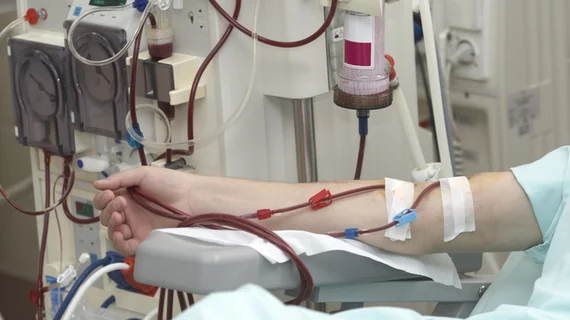New risk score helps cardiologists predict when TAVR patients may require dialysis
Researchers have developed a new risk score capable of predicting when patients may require dialysis after transcatheter aortic valve replacement (TAVR). The group shared its findings in full in the Journal of the American Heart Association.[1]
“Although relatively rare, newly required renal replacement therapy (RRT) after TAVR is a serious complication associated with very high mortality,” wrote first author Vincenzo Pasceri, MD, PhD, a cardiologist with San Filippo Neri Hospital in Italy, and colleagues. “Only a few studies have focused on the risk of RRT after TAVR and, although they have identified possible risk factors for the need for dialysis after TAVR, these data do not allow a clear definition of such risk before the procedure. Thus, we sought to analyze a large international multicentric registry of patients undergoing TAVR in order to develop and validate a simple risk score that could help to estimate the risk of severe acute kidney injury requiring dialysis of patients undergoing TAVR in contemporary practice.”
Pasceri et al. explored data from more than 10,000 patients who underwent TAVR in Europe from January 2012 to January 2022. Patients were excluded if they had a history of chronic dialysis prior to treatment or died within 48 hours. The study’s derivation cohort included two-thirds of patients, and the remaining patients made up its validation cohort.
The team developed the TRITAVIpre score, which focused on preprocedural variables associated with an increased risk of RRT. They then added procedural variables to their equations for a separate risk score, TRITAVIpost.
According to the TRITAVIpre risk score, men were associated with a higher risk of requiring dialysis than women. Diabetes, prior coronary artery bypass graft, anemia, nonfemoral access and creatinine clearance <30 mL/min per m2 were also linked to a heightened risk.
According to the TRITAVIpost risk score, meanwhile, the volume of contrast, need for transfusion and major vascular complications were all found to increase a patient’s risk of requiring post-TAVR dialysis.
Just 0.3% of patients who received a low TRITAVIpre score ended up requiring dialysis after TAVR. Among patients with a high TRITAVIpre score, that number increased to 3.9%. A similar trend was seen with the TRITAVIpost risk score; 0.1% of patients with a low score and 6.2% of patients with a high score required dialysis after TAVR.
Finally, the authors applied both risk scores to all patients from their validation cohort. Each score was able to identify patients who may face a higher risk of requiring post-TAVR dialysis. The C-statistics were 0.80 for TRITAVIpre and 0.81 for TRITAVIpost.
“Our study was able to determine factors associated with the need for RRT in a large contemporary population of patients undergoing TAVR,” the authors wrote. “A simple preprocedural clinical score can help assess the risk of this severe complication, which is associated with high mortality.”
Additional research is still needed, the group added, to learn more about this risk score's potential impact on patient care.
Click here to read the full study.

